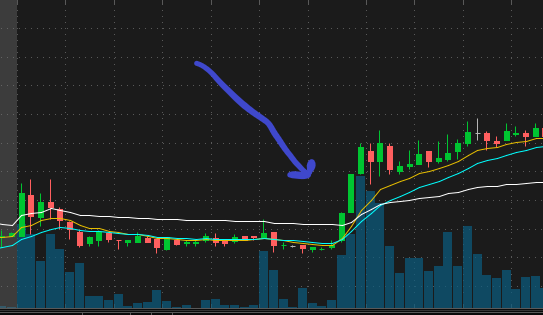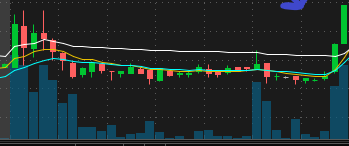What to Look For
Every good short squeeze is on a stock that has an usually large amount of relative volume, positive morning news, and low float.
Usually, a short squeeze is likely to happen on the one stock that the majority of traders are watching. Therefore, pre-market can get quite overcrowded resulting and a lackluster open when the bell finally rings. If this is the case, the first few mins of market open will look like a tug of war with a lot of volume.
Next, try to notice if there are traders going short. This usually happens when the pre-market high break is weak and volume fades after the first few minutes of market open. Most short traders will see this price action and think the price will fade all day. By now, most long traders have probably adverted attention elsewhere since the open was weak, and the ones who went long early most likely have stopped out. As a result, price action and volume will resemble a slight spike with more sell volume than buying.

Here is a textbook example. The Squeeze happened fast (a total of 3 minutes) and the held its levels above the previous high of day.
Mid-Morning Volume Fade
After about 10am EST price action will consolidate or slowly faded. This makes the stock appear to be done for the day. However, most short traders have to cover eventually. The goal here is to go long when the short traders are covering to ride the momentum and sell towards high of day. Entries on short squeezes can be tough, but one should look for covering to happen before lunch time while most short traders are still in their position. The safest trade would be to enter as price breaks the high of day after a pullback that is confirmed by volume, then sell as momentum slows on the time and sales tape. This is because once the price breaks high of day most shorts will stop out and scanner alerts will be set off. As a result, more long bias traders will notice, and this shifts momentum to the buying side. On the other hand, the most aggressive entry would be as the price breaks VWAP with high volume. Not only is this risky, but it is also hard to get the perfect entry. This is because most traders don't have scanner settings aren't programmed for early short squeeze entries. However, experienced traders will keep the stocks with these patterns on the side to negate the need for alerts.

Here you can see the tug of war price action at the bell. Then, volume fades, and eventually the price tests the VWAP (white line). The VWAP test is the first indication that Momentum is on the way.
History
Another great indicator of an incoming short squeeze is history. This includes a history of short squeezes in the past, multiple stock splits since the IPO, as well as a weak yearly (or extended period of time) chart with a lot of empty space and long distance to the moving averages. Empty space means that the stock price has been fading for a long time on light volume without testing the moving averages at all. Then, eventually, once the bottom is reached the price spikes. Most traders call this the bottom bounce and a great analogy to visualize this would be to imagine throwing a bouncy ball off a tall building. The ball will bounce high, but relative to building only a fraction of the height. The price is the ball and usually bounces when the stock releases positive news. Also, there will be more volume than ever before because long term shorts are stopping out and new long bias traders are taking positions.

It's important to look back on many different time frames to get the complete picture. Here you can see a lot of empty space on the 1 year chart. Along with the positive new story, it's a recipe for greatness.

